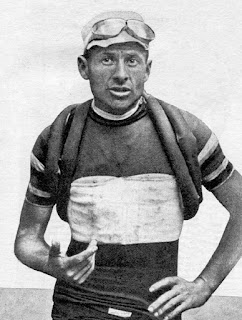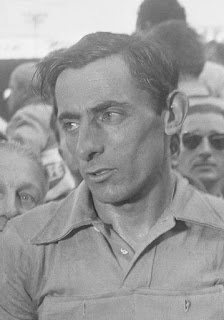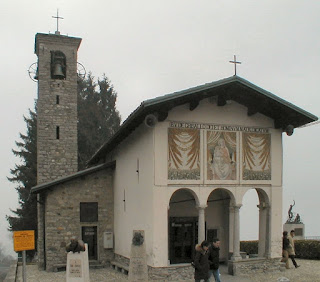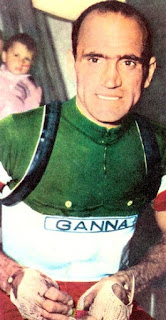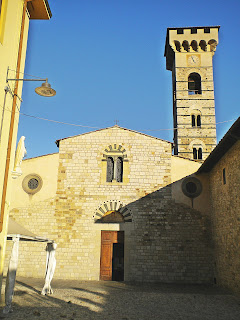Multiple title-winner who died tragically young
 |
| Fausto Coppi pictured after winning his second Tour de France in 1952 |
Although hugely successful and lauded for his talent and mental strength, Coppi was a controversial character. His rivalry with his fellow Italian rider Gino Bartali divided the nation, while he offended many in what was still a socially conservative country by abandoning his wife to live with another woman.
Fausto, who openly admitted to taking performance enhancing drugs, which were then legal, died in 1960 at the age of just 40 following a trip to Burkina Faso in West Africa. The cause of death officially was malaria but a story has circulated in more recent years that he was poisoned in an act of revenge.
The fourth in a family of five children, Coppi had poor health as he grew up and would skip school in order to amuse himself riding a rusty bicycle he found in a cellar. He left at the age of 13 to work in a butcher’s shop in Novi Ligure, a town about 20km (12 miles) from his home village in Piedmont.
There were many cyclists among the shop’s clientele and it was they who sparked Coppi’s interest in racing. His uncle, a merchant seaman who was also called Fausto, clubbed together with Coppi’s father, Domenico, to have a manufacturer in Genoa build him a racing bike, made to his measurements. The cost was 600 lire, a considerable sum at the time.
 |
| Coppi (right) with his great rival Gino Bartali (centre) at the Giro d'Italia of 1940, which Coppi won in controversial fashion |
His professional career was almost entirely defined by his often bitter rivalry with Bartali, who was the established star of Italian cycling when Coppi came on the scene, having won the Giro in 1936 and 1937 and the Tour de France in 1938.
It began in 1940, when Coppi was hired by the Legnano team to help Bartali win the Giro again. After Bartali suffered an early fall and struggled to stay with the peloton, a plan was devised in which Coppi would make an escape, leading the race at a punishing pace to tire the other contenders before dropping out and allowing Bartali to take charge.
Coppi is said to have agreed to the plan on the basis that he was unsure if he was in good enough physical condition to win the gruelling, 21-day race. Yet in the event he made his escape and never relinquished his lead, claiming afterwards that he felt stronger than he had anticipated and that, given that no one chased him, it was a chance to win the Giro that was too good to miss. Bartali, predictably, was furious and never lost his sense of indignation.
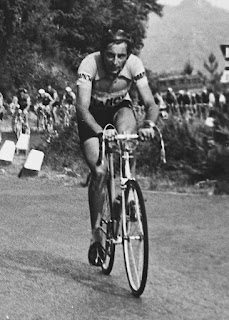 |
| Once Coppi had the lead in a race, he was often not caught |
The rivalry caused a sharp split among Italian cycling fans, too, and was seen by some commentators to represent the divides in the country. Bartali was seen as insular, conservative and religious, taking time to pray while he competed, and had the support of traditionalists, mainly in the south (although he was from Florence); Coppi, willing to be innovative with his training and diet, and to challenge convention in his private life, was seen as the more cosmopolitan, modern Italian, and as such became the hero of the economically ambitious urban north.
Coppi was the most successful, partly because he was prepared to travel in search of victories, winning prestigious races in France and Belgium and elsewhere, while Bartali preferred to stay close to home, although they each won the Tour de France twice. Coppi, however, took five Giro d’Italia titles to Bartali’s two.
The Second World War interrupted their rivalry. Coppi spent much of the war as a prisoner, having been captured by the British while fighting in northern Africa. Bartali, famously, risked his life by acting as a clandestine courier involved in helping Italian Jews escape from being deported to Nazi concentration camps.
| Coppi with Giulia Occhini, with whom he had an extra- marital affair that caused a national scandal in Italy |
Famous for his so-called innovative thinking in what he ate and drank in order to maximise his ability in the saddle, Coppi admitted he used supplements that would subsequently be banned, including amphetamines. Bartali became obsessed with what Coppi was taking during races, even sneaking into his rival’s hotel rooms to examine the contents of his waste bin, reasoning that if he could not accuse Coppi of cheating, since the use of pharmaceutical aids was not against the rules, he could at least anticipate how he was planning to ride.
Any opprobrium relating to his drug use, however, paled alongside the reaction to the news that broke in 1954 about Coppi’s private life and his relationship with Giulia Occhini, which caused a huge scandal in Italy and alienated many of his supporters.
Both he and Occhini were married, she the mother of two young children with her husband, who had been one of Coppi’s most passionate fans. At the time, adultery was still a criminal offence in Italy and eventually Coppi and his lover were arrested and put on trial for adultery, receiving suspended jail sentences. Later they married and had a child together, but the legitimacy of neither the marriage nor their son was recognised by the Italian authorities.
 |
| The monument to Fausto Coppi at Passo Pordoi, a mountain pass on the route of the Giro d'Italia |
In 2002, a report in the Italian newspaper Corriere dello Sport claimed that a French Benedictine priest working in Burkina Faso had been told while listening to a confession that Coppi had actually been poisoned in revenge for the death of an Ivory Coast rider he had forced off the road during a race in the country two years earlier. Requests were submitted to exhume his body and but they were declined.
Coppi’s honour has been rebuilt in recent years. A bonus prize in the Giro, the Cima Coppi, is now awarded to the first rider to reach the course’s highest summit, while the village of his birth was renamed Castellania Coppi by the Piedmont regional council in 2019. Numerous monuments to Coppi have been created, including one on the route of the Giro d'Italia at Passo Pordoi in the Dolomites,
 |
| The Palazzo delle Piane, one of several historic palaces in the Piedmont town of Novi Ligure |
In the 17th and 18th centuries, the town of Novi Ligure, where Coppi was introduced to the world of cycling, was a renowned resort for rich Genoese families, whose numerous noble palaces adorn the historical centre. These include Palazzo Negroni, Palazzo Durazzo and Palazzo Delle Piane, situated in Piazza Delle Piane. Novi has retained part of its walls, erected in 1447 and partly demolished in the 19th century, together with the tower of the Castle. There is a museum, the Museo dei Campionissimi, devoted to Coppi and another famous cyclist, Costante Girardengo. The town is now a centre for the production of chocolate, notably the Novi brand.
 |
| The Piazza del Duomo in Tortona, the city in which Coppi lived at the end of his career |
Tortona is an elegant small city of around 27,000 inhabitants in the eastern part of Piedmont, roughly halfway between Milan and the Ligurian coast at Genoa. It sits on the right bank of the Scrivia river between the plain of Marengo and the foothills of the Ligurian Apennines. Lorenzo Perosi, along with his brother, Carlo, is buried at the Duomo, where his father was the choir director. The Duomo has a 19th century neoclassical facade but the building itself dates back to the 16th century.
More reading:
Gino Bartali: The story of a secret war hero
Fiorenzo Magni, the last link with cycling's golden age
The tragedy of Marco Pantani
Also on this day:
1616: The first free public school opens in Frascati
1881: The birth of car manufacturer Ettore Bugatti
1904: The birth of Umberto II, the last king of Italy
Home

